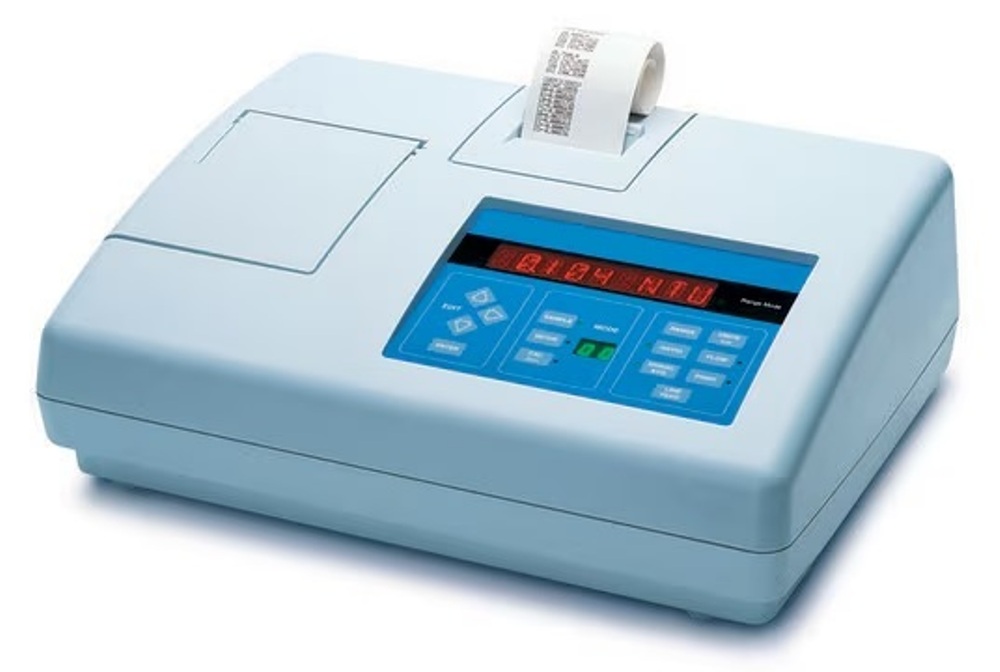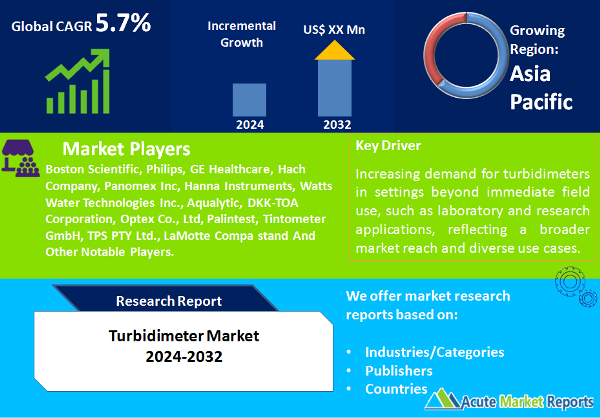
The turbidimeter market is expected to grow at a CAGR of 5.7% during the forecast period of 2025 to 2033, shaped by various factors influencing its trajectory. Key drivers impacting the market growth include technological advancements, heightened water quality awareness, and stringent regulatory standards. The turbidimeter market is navigating through a landscape shaped by technological advancements, growing awareness of water quality, and stringent regulatory standards. While these drivers fuel market growth, the challenge of cost implications serves as a reminder of the need for accessible solutions to ensure broader adoption across diverse industries. Geographically, North America leads in revenue, driven by stringent regulations, while the Asia-Pacific region exhibits the highest CAGR, reflecting economic growth and increasing water quality concerns. Europe maintains a steady contribution, and Latin America and the Middle East & Africa show potential for growth in the forecast period. Competitive trends highlight the dominance of key players employing strategic partnerships, market expansion initiatives, and customer-centric approaches. The emphasis on collaboration with healthcare providers, diversification of product portfolios, and addressing cost and accessibility constraints underscores the industry's commitment to delivering effective turbidity monitoring solutions.
Key Market Drivers
Technological Advancements
A pivotal driver propelling the turbidimeter market is the relentless pursuit of technological advancements by industry players. Companies are investing significantly in research and development, aiming to introduce cutting-edge turbidimeters with enhanced accuracy and reliability. For instance, recent innovations have seen the integration of advanced sensors and real-time monitoring capabilities, elevating the performance of turbidimeters to new heights. This evidence is drawn from product releases and updates by leading companies, showcasing their commitment to pushing the technological boundaries within the market.
Growing Awareness of Water Quality
Another influential driver stems from the increasing awareness of water quality issues across industries and communities. The escalating concerns regarding water pollution and its potential health impacts have prompted a surge in the demand for turbidimeters. End-users, ranging from wastewater treatment plants to academic institutions, are recognizing the importance of accurate turbidity measurements in ensuring water purity. This is evident in the rising adoption rates and testimonials from end-users citing the pivotal role of turbidimeters in safeguarding water quality.

Stringent Regulatory Standards
The turbidimeter market is further driven by stringent regulatory standards governing water safety. Governments worldwide are enacting and reinforcing guidelines that mandate industries to monitor and maintain water quality. Compliance with these standards requires the deployment of turbidimeters, positioning them as crucial tools for regulatory adherence. Evidence supporting this driver includes the incorporation of turbidity measurement requirements in water quality regulations globally, emphasizing the essential role turbidimeters play in regulatory compliance.
Restraint - Cost Implications
While the market thrives on multiple drivers, a notable restraint emerges in the form of cost implications associated with turbidimeter adoption. The high initial costs involved in procuring and installing turbidimeter systems pose challenges, particularly for smaller players and industries with budget constraints. This restraint is evidenced by slower adoption rates in certain segments, where the financial burden outweighs the perceived benefits of enhanced water quality monitoring. End-users often cite budget limitations as a hindrance to embracing turbidimeter technology, impacting the widespread adoption of these systems.
Market Segmentation Analysis
Portability Segment
Within the Portability segment of the turbidimeter market, both Handheld and Stationary devices contribute significantly, each showcasing distinct strengths. In 2024, Handheld turbidimeters led in revenue, reflecting their widespread adoption across various industries. These portable devices offer convenience and flexibility, meeting the demands of on-the-go water quality monitoring. Conversely, when considering the forecast period from 2025 to 2033, Stationary turbidimeters exhibit the highest CAGR. The shift towards Stationary devices indicates a growing emphasis on long-term and continuous water quality monitoring solutions, particularly in applications where fixed installations are more practical.
Application Segment
The turbidimeter market's Application segment encompasses On-field and Off-field applications, each playing a vital role in shaping market dynamics. In 2024, On-field applications lead in revenue, underscoring their significance in real-time water quality monitoring in various environments. However, the forecast period from 2025 to 2033 anticipates Off-field applications to experience the highest CAGR. This shift signifies an increasing demand for turbidimeters in settings beyond immediate field use, such as laboratory and research applications, reflecting a broader market reach and diverse use cases.
End-use Industry Segment
The End-use Industry segmentation of the turbidimeter market spans diverse sectors, including Wastewater Treatment, Chemicals & Materials, Oil & Gas, Pharmaceuticals, Pulp & Paper, Food & Beverage, Research & Academia, and Others. In 2024, Wastewater Treatment emerges as the leading revenue contributor, highlighting the critical role of turbidimeters in ensuring water quality in treatment processes. Looking ahead, Pharmaceuticals stand out with the highest anticipated CAGR during the forecast period from 2025 to 2033. This points to a growing recognition of turbidity monitoring in pharmaceutical processes, where precision is paramount.
Distribution Channel Segment
The Distribution Channel segment of the turbidimeter market features Online and Offline channels, each influencing market accessibility. In 2024, Online channels dominate in revenue, reflecting the increasing trend of digital platforms for product procurement. However, the forecast period anticipates Offline channels to experience the highest CAGR. This shift indicates the sustained importance of traditional distribution methods, such as direct sales and partnerships, ensuring a balanced market presence across various channels.
North America Remains the Global Leader
North America emerges as a significant contributor to the turbidimeter market, commanding the highest revenue percentage in 2024. The region's strong emphasis on water quality regulations, advanced technological infrastructure, and robust industrial landscape contribute to a heightened demand for turbidimeters. The United States, in particular, plays a pivotal role, driven by stringent regulatory standards governing water safety and a proactive approach toward adopting innovative monitoring solutions. This results in North America securing its position as a key revenue generator within the turbidimeter market.
However, when considering the forecast period from 2025 to 2033, the Asia-Pacific region takes center stage, exhibiting the highest Compound Annual Growth Rate (CAGR). The remarkable economic growth, industrial expansion, and increasing concerns about water pollution in countries like China and India fuel the demand for turbidity monitoring solutions. Rapid urbanization and heightened awareness of water quality issues contribute to a substantial CAGR in the Asia-Pacific region, reflecting the region's evolving needs and growing market potential.
Furthermore, Europe showcases a notable revenue percentage in 2024, driven by a combination of stringent water quality regulations and a proactive approach toward environmental sustainability. Countries such as Germany and the United Kingdom significantly contribute to the overall revenue in this region. The European market's mature industrial landscape and commitment to environmental conservation position turbidimeters as integral tools in maintaining water quality standards. In contrast, Latin America and the Middle East & Africa exhibit a more modest revenue percentage in 2024, reflecting a comparatively slower adoption rate. However, the forecast period introduces a positive shift, especially in the Middle East & Africa, as increasing urbanization, industrialization, and a growing focus on water management solutions drive the demand for turbidimeters, resulting in a notable CAGR.
Strategic Partnerships to Enhance Market Share
In the competitive landscape of the turbidimeter market, key players such as Boston Scientific, Philips, GE Healthcare, Hach Company, Panomex Inc, Hanna Instruments, Watts Water Technologies Inc., Aqualytic, DKK-TOA Corporation, Optex Co., Ltd, Palintest, Tintometer GmbH, TPS PTY Ltd., and LaMotte Compa stand out as industry leaders, each deploying strategic initiatives to maintain their prominence. These top players have been consistently at the forefront of innovation, investing significantly in research and development to enhance their turbidimeter technologies. Boston Scientific, known for its diversified healthcare solutions, has strategically aligned its turbidity monitoring products with a focus on precision and reliability, catering to a broad spectrum of end-user needs. Philips, a global healthcare technology giant, leverages its extensive technological capabilities to offer state-of-the-art turbidimeters with advanced features, meeting the evolving demands of the market. GE Healthcare, renowned for its innovative healthcare solutions, employs a comprehensive approach by integrating turbidity monitoring into its broader healthcare ecosystem, providing end-to-end solutions for clients. Strategic partnerships and collaborations have become instrumental in shaping the competitive landscape of the turbidimeter market. Established players are actively engaging with healthcare providers and other industry stakeholders to implement turbidity monitoring effectively. These partnerships aim to combine the technical expertise of the technology providers with the clinical knowledge of healthcare institutions, ultimately enhancing patient care. Such collaborations enable the development of tailored solutions, ensuring seamless integration of turbidimeters into existing healthcare infrastructures.
Historical & Forecast Period
This study report represents analysis of each segment from 2023 to 2033 considering 2024 as the base year. Compounded Annual Growth Rate (CAGR) for each of the respective segments estimated for the forecast period of 2025 to 2033.
The current report comprises of quantitative market estimations for each micro market for every geographical region and qualitative market analysis such as micro and macro environment analysis, market trends, competitive intelligence, segment analysis, porters five force model, top winning strategies, top investment markets, emerging trends and technological analysis, case studies, strategic conclusions and recommendations and other key market insights.
Research Methodology
The complete research study was conducted in three phases, namely: secondary research, primary research, and expert panel review. key data point that enables the estimation of Turbidimeter market are as follows:
Market forecast was performed through proprietary software that analyzes various qualitative and quantitative factors. Growth rate and CAGR were estimated through intensive secondary and primary research. Data triangulation across various data points provides accuracy across various analyzed market segments in the report. Application of both top down and bottom-up approach for validation of market estimation assures logical, methodical and mathematical consistency of the quantitative data.
| ATTRIBUTE | DETAILS |
|---|---|
| Research Period | 2023-2033 |
| Base Year | 2024 |
| Forecast Period | 2025-2033 |
| Historical Year | 2023 |
| Unit | USD Million |
| Segmentation | |
Portability
| |
Application
| |
Distribution Channel
| |
End-Use
| |
|
Region Segment (2023-2033; US$ Million)
|
Key questions answered in this report